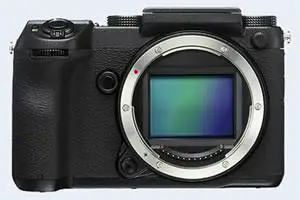Fujifilm GFX 50S vs Pentax 645D
The Fujifilm GFX 50S and the Pentax 645D are two professional cameras that were officially introduced, respectively, in September 2016 and March 2010. The GFX 50S is a mirrorless interchangeable lens camera, while the 645D is a DSLR. Both cameras are equipped with a medium format sensor. The Fujifilm has a resolution of 51.1 megapixels, whereas the Pentax provides 39.5 MP.
Below is an overview of the main specs of the two cameras as a starting point for the comparison.

Check GFX 50S offers at
ebay.com

Check 645D offers at
ebay.com
Going beyond this snapshot of core features and characteristics, what are the differences between the Fujifilm GFX 50S and the Pentax 645D? Which one should you buy? Read on to find out how these two cameras compare with respect to their body size, their imaging sensors, their shooting features, their input-output connections, and their reception by expert reviewers.
Body comparison
The side-by-side display below illustrates the physical size and weight of the Fujifilm GFX 50S and the Pentax 645D. The two cameras are presented according to their relative size. Three successive views from the front, the top, and the rear are shown. All size dimensions are rounded to the nearest millimeter.
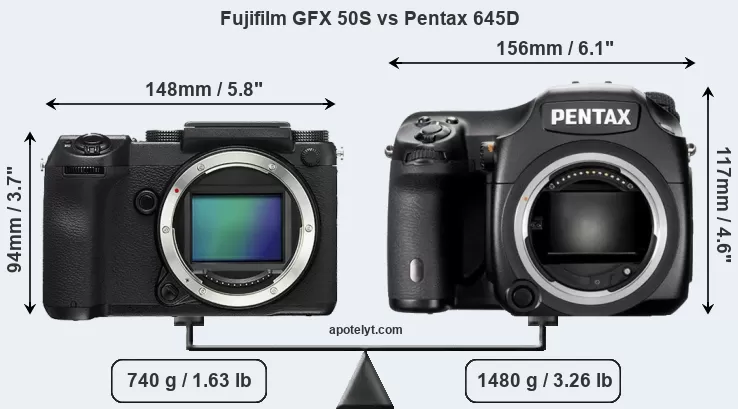
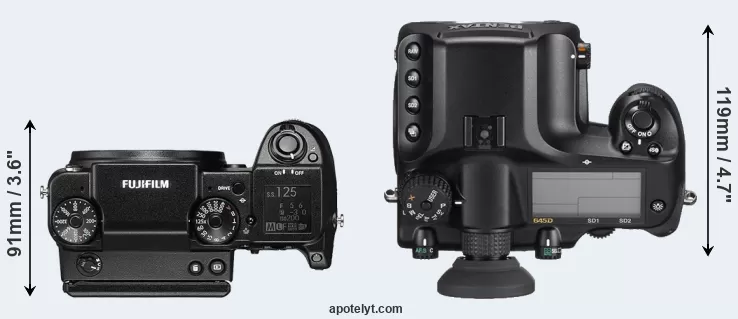
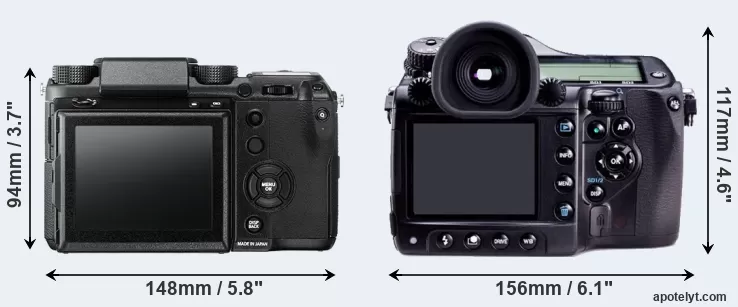
If the front view area (width x height) of the cameras is taken as an aggregate measure of their size, the Pentax 645D is notably larger (31 percent) than the Fujifilm GFX 50S. Moreover, the 645D is substantially heavier (100 percent) than the GFX 50S. In this context, it is worth noting that both cameras are splash and dust-proof and can, hence, be used in inclement weather conditions or harsh environments.
The above size and weight comparisons are to some extent incomplete since they do not consider the interchangeable lenses that both of these cameras require. Hence, you might want to study and compare the specifications of available lenses in order to get the full picture of the size and weight of the two camera systems.
Concerning battery life, the GFX 50S gets 400 shots out of its Fujifilm NP-T125 battery, while the 645D can take 800 images on a single charge of its Pentax D-LI90 power pack.
The following table provides a synthesis of the main physical specifications of the two cameras and other similar ones. In case you want to display and compare another camera duo, you can use the CAM-parator app to select your camera combination among a large number of options.

| Camera Model |
Camera Width |
Camera Height |
Camera Depth |
Camera Weight |
Battery Life |
Weather Sealing |
Camera Launch |
Launch Price (USD) |
Street Price |
||
|---|---|---|---|---|---|---|---|---|---|---|---|
| 1. | Fujifilm GFX 50S | 148 mm | 94 mm | 91 mm | 740 g | 400 | Y | Sep 2016 | 6,499 | ebay.com | |
| 2. | Pentax 645D | 156 mm | 117 mm | 119 mm | 1480 g | 800 | Y | Mar 2010 | 9,995 | ebay.com | |
| 3. | Canon 1D Mark IV | 156 mm | 157 mm | 80 mm | 1230 g | 1500 | Y | Oct 2009 | 4,999 | ebay.com | |
| 4. | Canon 1D X | 158 mm | 168 mm | 83 mm | 1551 g | 1120 | Y | Oct 2011 | 6,799 | ebay.com | |
| 5. | Canon 5D Mark IV | 151 mm | 116 mm | 76 mm | 890 g | 900 | Y | Aug 2016 | 3,499 | amazon.com | |
| 6. | Fujifilm GFX 50R | 161 mm | 97 mm | 66 mm | 775 g | 400 | Y | Sep 2018 | 4,499 | ebay.com | |
| 7. | Fujifilm GFX 50S II | 150 mm | 104 mm | 87 mm | 900 g | 440 | Y | Sep 2021 | 3,999 | amazon.com | |
| 8. | Fujifilm GFX 100 II | 152 mm | 117 mm | 99 mm | 1030 g | 540 | Y | Sep 2023 | 7,499 | amazon.com | |
| 9. | Fujifilm GFX 100S | 150 mm | 104 mm | 87 mm | 900 g | 460 | Y | Jan 2021 | 5,999 | amazon.com | |
| 10. | Hasselblad X1D | 150 mm | 98 mm | 71 mm | 725 g | .. | Y | Jun 2016 | 8,995 | ebay.com | |
| 11. | Hasselblad X1D II | 148 mm | 97 mm | 70 mm | 766 g | .. | Y | Jun 2019 | 5,750 | ebay.com | |
| 12. | Leica M10 | 139 mm | 80 mm | 39 mm | 660 g | 210 | Y | Jan 2017 | 6,595 | ebay.com | |
| 13. | Leica Q3 | 130 mm | 80 mm | 93 mm | 743 g | 350 | Y | May 2023 | 5,995 | amazon.com | |
| 14. | Leica S Typ 006 | 160 mm | 120 mm | 80 mm | 1260 g | .. | Y | Sep 2012 | 21,950 | ebay.com | |
| 15. | Leica SL | 147 mm | 104 mm | 39 mm | 847 g | 400 | Y | Oct 2015 | 7,450 | ebay.com | |
| 16. | Nikon D3S | 160 mm | 157 mm | 88 mm | 1240 g | 4200 | Y | Oct 2009 | 5,199 | ebay.com | |
| 17. | Pentax 645Z | 156 mm | 117 mm | 123 mm | 1550 g | 650 | Y | Apr 2014 | 8,499 | ebay.com | |
| Note: Measurements and pricing do not include easily detachable parts, such as add-on or interchangeable lenses or optional viewfinders. | |||||||||||
The price is, of course, an important factor in any camera decision. The manufacturer’s suggested retail prices give an idea on the placement of the camera in the maker’s lineup and the broader market. The GFX 50S was launched at a markedly lower price (by 35 percent) than the 645D, which puts it into a different market segment. Usually, retail prices stay at first close to the launch price, but after several months, discounts become available. Later in the product cycle and, in particular, when the replacement model is about to appear, further discounting and stock clearance sales often push the camera price considerably down. Then, after the new model is out, very good deals can frequently be found on the pre-owned market.
Sensor comparison
The imaging sensor is at the core of digital cameras and its size is one of the main determining factors of image quality. All other things equal, a large sensor will have larger individual pixel-units that offer better low-light sensitivity, wider dynamic range, and richer color-depth than smaller pixels in a sensor of the same technological generation. Further, a large sensor camera will give the photographer additional creative options when using shallow depth-of-field to isolate a subject from its background. On the downside, larger sensors tend to be more expensive and lead to bigger and heavier cameras and lenses.
Both cameras under consideration feature a medium format sensor and have a format factor (sometimes also referred to as "crop factor") of 0.79. Within the spectrum of camera sensors, this places the review cameras among the large-sensor cameras that aim for top notch image quality. Both cameras feature a native aspect ratio (sensor width to sensor height) of 4:3.
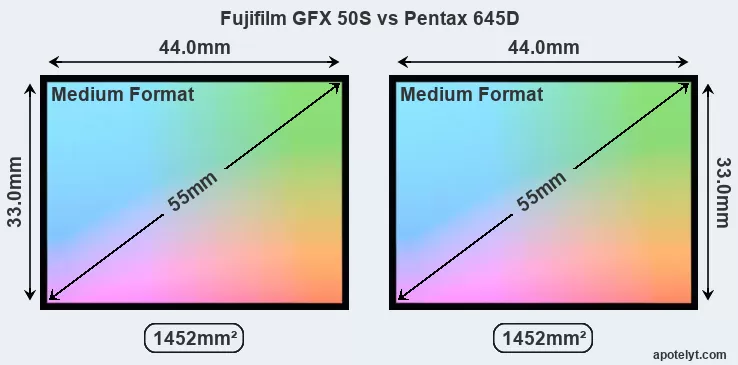
While the two cameras under review share the same sensor size, the GFX 50S offers a higher resolution of 51.1 megapixels, compared with 39.5 MP of the 645D. This megapixels advantage translates into a 14 percent gain in linear resolution. On the other hand, these sensor specs imply that the GFX 50S has a higher pixel density and a smaller size of the individual pixel (with a pixel pitch of 5.33μm versus 6.06μm for the 645D). In this context, it should be noted, however, that the GFX 50S is much more recent (by 6 years and 6 months) than the 645D, and its sensor will have benefitted from technological advances during this time that compensate for the smaller pixel size. Coming back to sensor resolution, it should be mentioned that neither of the two cameras has an anti-alias filter installed, so they are able to capture all the detail the sensor resolves.
The resolution advantage of the Fujifilm GFX 50S implies greater flexibility for cropping images or the possibility to print larger pictures. The maximum print size of the GFX 50S for good quality output (200 dots per inch) amounts to 41.3 x 31 inches or 104.9 x 78.6 cm, for very good quality (250 dpi) 33 x 24.8 inches or 83.9 x 62.9 cm, and for excellent quality (300 dpi) 27.5 x 20.6 inches or 69.9 x 52.4 cm. The corresponding values for the Pentax 645D are 36.3 x 27.2 inches or 92.3 x 69.1 cm for good quality, 29.1 x 21.8 inches or 73.8 x 55.3 cm for very good quality, and 24.2 x 18.1 inches or 61.5 x 46.1 cm for excellent quality prints.
The Fujifilm GFX 50S has a native sensitivity range from ISO 100 to ISO 12800, which can be extended to ISO 50-102400. The corresponding ISO settings for the Pentax 645D are ISO 100 to ISO 1600 (no boost).
In terms of underlying technology, the GFX 50S is build around a CMOS sensor, while the 645D uses a CCD imager. Both cameras use a Bayer filter for capturing RGB colors on a square grid of photosensors. This arrangement is found in most digital cameras.
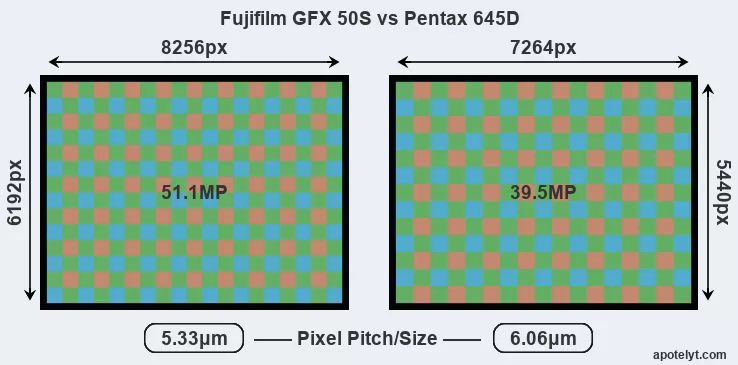
For many cameras, data on sensor performance has been reported by DXO Mark. This service assesses and scores the color depth ("DXO Portrait"), dynamic range ("DXO Landscape"), and low-light sensitivity ("DXO Sports") of camera sensors, and also publishes an overall camera score. The following table provides an overview of the physical sensor characteristics, as well as the sensor quality measurements for a selection of comparators.

| Camera Model |
Sensor Class |
Resolution (MP) |
Horiz. Pixels |
Vert. Pixels |
Video Format |
DXO Portrait |
DXO Landscape |
DXO Sports |
DXO Overall |
||
|---|---|---|---|---|---|---|---|---|---|---|---|
| 1. | Fujifilm GFX 50S | Medium Format | 51.1 | 8256 | 6192 | 1080/30p | 25.4 | 14.1 | 2977 | 96 | |
| 2. | Pentax 645D | Medium Format | 39.5 | 7264 | 5440 | none | 24.6 | 12.6 | 1262 | 82 | |
| 3. | Canon 1D Mark IV | APS-H | 16.0 | 4896 | 3264 | 1080/30p | 22.8 | 12.0 | 1320 | 74 | |
| 4. | Canon 1D X | Full Frame | 17.9 | 5184 | 3456 | 1080/30p | 23.8 | 11.8 | 2786 | 82 | |
| 5. | Canon 5D Mark IV | Full Frame | 30.1 | 6720 | 4480 | 4K/30p | 24.8 | 13.6 | 2995 | 91 | |
| 6. | Fujifilm GFX 50R | Medium Format | 51.1 | 8256 | 6192 | 1080/30p | 25.7 | 14.4 | 3169 | 98 | |
| 7. | Fujifilm GFX 50S II | Medium Format | 51.1 | 8256 | 6192 | 1080/30p | 25.9 | 14.8 | 3456 | 100 | |
| 8. | Fujifilm GFX 100 II | Medium Format | 101.8 | 11648 | 8736 | 8K/30p | 25.9 | 15.0 | 3651 | 101 | |
| 9. | Fujifilm GFX 100S | Medium Format | 101.8 | 11648 | 8736 | 4K/30p | 25.8 | 14.7 | 3391 | 100 | |
| 10. | Hasselblad X1D | Medium Format | 51.3 | 8272 | 6200 | 1080/25p | 26.2 | 14.8 | 4489 | 102 | |
| 11. | Hasselblad X1D II | Medium Format | 51.3 | 8272 | 6200 | 1080/25p | 25.7 | 14.5 | 3234 | 99 | |
| 12. | Leica M10 | Full Frame | 23.8 | 5952 | 3992 | none | 24.4 | 13.2 | 2133 | 86 | |
| 13. | Leica Q3 | Full Frame | 60.3 | 9528 | 6328 | 8K/30p | 25.4 | 14.7 | 3216 | 96 | |
| 14. | Leica S Typ 006 | Medium Format | 37.5 | 7500 | 5000 | none | 23.9 | 12.2 | 824 | 76 | |
| 15. | Leica SL | Full Frame | 24.0 | 6000 | 4000 | 4K/30p | 25.0 | 13.4 | 1821 | 88 | |
| 16. | Nikon D3S | Full Frame | 12.1 | 4256 | 2832 | 720/24p | 23.5 | 12.0 | 3253 | 82 | |
| 17. | Pentax 645Z | Medium Format | 51.1 | 8256 | 6192 | 1080/60i | 26.0 | 14.7 | 4505 | 101 | |
| Note: DXO values in italics represent estimates based on sensor size and age. | |||||||||||
Many modern cameras cannot only take still pictures, but also record videos. The GFX 50S indeed provides movie recording capabilities, while the 645D does not. The highest resolution format that the GFX 50S can use is 1080/30p.
Feature comparison
Apart from body and sensor, cameras can and do differ across a range of features. For example, the 645D has an optical viewfinder, which can be very useful when shooting in bright sunlight. In contrast, the GFX 50S relies on live view and the rear LCD for framing. That said, the GFX 50S can be equipped with an optional viewfinder – the EVF-TL1. The table below summarizes some of the other core capabilities of the Fujifilm GFX 50S and Pentax 645D in connection with corresponding information for a sample of similar cameras.

| Camera Model |
Viewfinder (Type or 000 dots) |
Control Panel (yes/no) |
LCD Specifications (inch/000 dots) |
LCD Attach- ment |
Touch Screen (yes/no) |
Max Shutter Speed * |
Max Shutter Flaps * |
Built-in Flash (yes/no) |
Built-in Image Stab |
||
|---|---|---|---|---|---|---|---|---|---|---|---|
| 1. | Fujifilm GFX 50S | optional | Y | 3.2 / 2360 | full-flex | Y | 1/4000s | 3.0/s | n | n | |
| 2. | Pentax 645D | optical | Y | 3.0 / 921 | fixed | n | 1/4000s | 1.1/s | n | n | |
| 3. | Canon 1D Mark IV | optical | Y | 3.0 / 920 | fixed | n | 1/8000s | 10.0/s | n | n | |
| 4. | Canon 1D X | optical | Y | 3.2 / 1040 | fixed | n | 1/8000s | 14.0/s | n | n | |
| 5. | Canon 5D Mark IV | optical | Y | 3.2 / 1620 | fixed | Y | 1/8000s | 7.0/s | n | n | |
| 6. | Fujifilm GFX 50R | 3690 | n | 3.2 / 2360 | tilting | Y | 1/4000s | 3.0/s | n | n | |
| 7. | Fujifilm GFX 50S II | 3690 | Y | 3.2 / 2360 | full-flex | Y | 1/4000s | 3.0/s | n | Y | |
| 8. | Fujifilm GFX 100 II | 9440 | Y | 3.2 / 2360 | full-flex | Y | 1/4000s | 8.0/s | n | Y | |
| 9. | Fujifilm GFX 100S | 3690 | Y | 3.2 / 2360 | full-flex | Y | 1/4000s | 5.0/s | n | Y | |
| 10. | Hasselblad X1D | 2360 | n | 3.0 / 920 | fixed | Y | 1/2000s | 2.3/s | n | n | |
| 11. | Hasselblad X1D II | 3690 | n | 3.6 / 2360 | fixed | Y | 1/2000s | 2.7/s | n | n | |
| 12. | Leica M10 | optical | n | 3.0 / 1037 | fixed | n | 1/4000s | 5.0/s | n | n | |
| 13. | Leica Q3 | 5760 | n | 3.0 / 1840 | tilting | Y | 1/2000s | 15.0/s | n | Y | |
| 14. | Leica S Typ 006 | optical | Y | 3.0 / 922 | fixed | n | 1/4000s | 1.5/s | n | n | |
| 15. | Leica SL | 4400 | Y | 3.0 / 1040 | fixed | Y | 1/8000s | 11.0/s | n | n | |
| 16. | Nikon D3S | optical | Y | 3.0 / 921 | fixed | n | 1/8000s | 11.0/s | n | n | |
| 17. | Pentax 645Z | optical | Y | 3.2 / 1037 | tilting | n | 1/4000s | 3.0/s | n | n | |
| Note: *) Information refers to the mechanical shutter, unless the camera only has an electronic one. | |||||||||||
One differentiating feature between the two cameras concerns the touch sensitivity of the rear screen. The GFX 50S has a touchscreen, while the 645D has a conventional panel. Touch control can be particularly helpful, for example, for setting the focus point.
The reported shutter speed information refers to the use of the mechanical shutter. Yet, some cameras only have an electronic shutter, while others have an electronic shutter in addition to a mechanical one. In fact, the GFX 50S is one of those camera that have an additional electronic shutter, which makes completely silent shooting possible. However, this mode is less suitable for photographing moving objects (risk of rolling shutter) or shooting under artificial light sources (risk of flickering).
The Fujifilm GFX 50S and the Pentax 645D both have an intervalometer built-in. This enables the photographer to capture time lapse sequences, such as flower blooming, a sunset or moon rise, without purchasing an external camera trigger and related software.
Concerning the storage of imaging data, both the GFX 50S and the 645D write their files to SDXC cards. Both cameras feature dual card slots, which can be very useful in case a memory card fails. The GFX 50S supports UHS-II cards (on both slots), while the 645D cannot take advantage of Ultra High Speed SD cards.
Connectivity comparison
For some imaging applications, the extent to which a camera can communicate with its environment can be an important aspect in the camera decision process. The table below provides an overview of the connectivity of the Fujifilm GFX 50S and Pentax 645D and, in particular, the interfaces the cameras (and selected comparators) provide for accessory control and data transfer.

| Camera Model |
Hotshoe Port |
Internal Mic / Speaker |
Microphone Port |
Headphone Port |
HDMI Port |
USB Port |
WiFi Support |
NFC Support |
Bluetooth Support |
||
|---|---|---|---|---|---|---|---|---|---|---|---|
| 1. | Fujifilm GFX 50S | Y | stereo / mono | Y | Y | micro | 3.0 | Y | - | - | |
| 2. | Pentax 645D | Y | stereo / - | - | - | - | 2.0 | - | - | - | |
| 3. | Canon 1D Mark IV | Y | stereo / - | Y | - | mini | 2.0 | - | - | - | |
| 4. | Canon 1D X | Y | mono / - | Y | - | mini | 2.0 | - | - | - | |
| 5. | Canon 5D Mark IV | Y | mono / mono | Y | Y | mini | 3.0 | Y | Y | - | |
| 6. | Fujifilm GFX 50R | Y | stereo / mono | Y | Y | micro | 3.0 | Y | - | Y | |
| 7. | Fujifilm GFX 50S II | Y | stereo / mono | Y | Y | micro | 3.2 | Y | - | - | |
| 8. | Fujifilm GFX 100 II | Y | stereo / mono | Y | Y | full | 3.2 | Y | - | Y | |
| 9. | Fujifilm GFX 100S | Y | stereo / mono | Y | Y | micro | 3.2 | Y | - | Y | |
| 10. | Hasselblad X1D | Y | stereo / mono | Y | Y | mini | 3.0 | Y | - | - | |
| 11. | Hasselblad X1D II | Y | stereo / mono | Y | Y | - | 3.0 | Y | - | - | |
| 12. | Leica M10 | Y | - / - | - | - | - | - | Y | - | - | |
| 13. | Leica Q3 | Y | stereo / mono | - | - | micro | 3.1 | Y | - | Y | |
| 14. | Leica S Typ 006 | Y | - / - | - | - | mini | 2.0 | - | - | - | |
| 15. | Leica SL | Y | stereo / mono | Y | Y | full | 3.0 | Y | - | - | |
| 16. | Nikon D3S | Y | stereo / - | - | - | mini | 2.0 | - | - | - | |
| 17. | Pentax 645Z | Y | stereo / mono | Y | - | mini | 3.0 | - | - | - |
It is notable that the GFX 50S offers wifi support, while the 645D does not. Wifi can be a very convenient means to transfer image data to an off-camera location.
Both cameras feature a PC Sync terminal to control professional strobe lights, which will be appreciated by studio photographers.
Both the GFX 50S and the 645D have been discontinued, but can regularly be found used on ebay. The 645D was replaced by the Pentax 645Z, while the GFX 50S was followed by the Fujifilm GFX 50S II. Further information on the features and operation of the GFX 50S and 645D can be found, respectively, in the Fujifilm GFX 50S Manual (free pdf) or the online Pentax 645D Manual.
Review summary
So what conclusions can be drawn? Is the Fujifilm GFX 50S better than the Pentax 645D or vice versa? The listing below highlights the relative strengths of the two models.

Advantages of the Fujifilm GFX 50S:
- More detail: Offers more megapixels (51.1 vs 39.5MP) with a 14% higher linear resolution.
- Broader imaging potential: Can record not only still images but also 1080/30p movies.
- Larger screen: Has a bigger rear LCD (3.2" vs 3.0") for image review and settings control.
- More detailed LCD: Has a higher resolution rear screen (2360k vs 921k dots).
- More flexible LCD: Has a full-flex screen for odd-angle shots in portrait or landscape orientation.
- Fewer buttons to press: Is equipped with a touch-sensitive rear screen to facilitate handling.
- Faster burst: Shoots at higher frequency (3 vs 1.1 flaps/sec) to capture the decisive moment.
- Less disturbing: Has an electronic shutter option for completely silent shooting.
- More compact: Is smaller (148x94mm vs 156x117mm) and thus needs less room in the bag.
- Less heavy: Is lighter (by 740g or 50 percent) and hence easier to carry around.
- More legacy lens friendly: Can take a broad range of non-native lenses via adapters.
- Faster data transfer: Supports a more advanced USB protocol (3.0 vs 2.0).
- Easier file upload: Has wifi built in for automatic backup or image transfer to the web.
- Faster buffer clearing: Supports Ultra High Speed (UHS-II) SDXC cards on both slots.
- More affordable: Was introduced into a lower priced category (35 percent cheaper at launch).
- More modern: Reflects 6 years and 6 months of technical progress since the 645D launch.

Reasons to prefer the Pentax 645D:
- Easier framing: Has an optical viewfinder for image composition and settings control.
- Longer lasting: Gets more shots (800 versus 400) out of a single battery charge.
- More heavily discounted: Has been around for much longer (launched in March 2010).
If the number of relative strengths (bullet points above) is taken as a guide, the GFX 50S is the clear winner of the match-up (16 : 3 points). However, the relative importance of the various individual camera aspects will vary according to personal preferences and needs, so that you might like to apply corresponding weights to the particular features before making a decision on a new camera. A professional wedding photographer will view the differences between cameras in a way that diverges from the perspective of a travel photog, and a person interested in cityscapes has distinct needs from a macro shooter. Hence, the decision which camera is best and worth buying is often a very personal one.
How about other alternatives? Do the specifications of the Fujifilm GFX 50S and the Pentax 645D place the cameras among the top in their class? Find out in the latest Best Mirrorless Interchangeable Lens Camera and Best DSLR Camera listings whether the two cameras rank among the cream of the crop.
In any case, while the comparison of technical specifications can provide a useful overview of the capabilities of different cameras, it remains incomplete and does no justice, for example, to the way the GFX 50S or the 645D perform in practice. User reviews, such as those found at amazon, can sometimes inform about these issues, but such feedback is often incomplete, inconsistent, and biased.
Expert reviews
This is why hands-on reviews by experts are important. The following table reports the overall ratings of the cameras as published by some of the major camera review sites (amateurphotographer [AP], cameralabs [CL], digitalcameraworld [DCW], dpreview [DPR], ephotozine [EPZ], photographyblog [PB]). As can be seen, the professional reviewers agree in many cases on the quality of different cameras, but sometimes their assessments diverge, reinforcing the earlier point that a camera decision is often a very personal choice.

| Camera Model |
AP score |
CL score |
DCW score |
DPR score |
EPZ score |
PB score |
Camera Launch |
Launch Price (USD) |
Street Price |
||
|---|---|---|---|---|---|---|---|---|---|---|---|
| 1. | Fujifilm GFX 50S | .. | .. | 4.5/5 | 85/100 | 5/5 | 4.5/5 | Sep 2016 | 6,499 | ebay.com | |
| 2. | Pentax 645D | 5/5 | .. | .. | .. | .. | .. | Mar 2010 | 9,995 | ebay.com | |
| 3. | Canon 1D Mark IV | 5/5 | .. | .. | 89/100 | .. | .. | Oct 2009 | 4,999 | ebay.com | |
| 4. | Canon 1D X | 5/5 | .. | .. | .. | 4.5/5 | 4.5/5 | Oct 2011 | 6,799 | ebay.com | |
| 5. | Canon 5D Mark IV | 4.5/5 | + + | 4/5 | 87/100 | 4.5/5 | 4.5/5 | Aug 2016 | 3,499 | amazon.com | |
| 6. | Fujifilm GFX 50R | 5/5 | .. | 5/5 | 84/100 | 4.5/5 | 4.5/5 | Sep 2018 | 4,499 | ebay.com | |
| 7. | Fujifilm GFX 50S II | 5/5 | .. | 5/5 | 87/100 | .. | 5/5 | Sep 2021 | 3,999 | amazon.com | |
| 8. | Fujifilm GFX 100 II | 5/5 | + | 5/5 | .. | .. | 4.5/5 | Sep 2023 | 7,499 | amazon.com | |
| 9. | Fujifilm GFX 100S | 5/5 | + + | 5/5 | 90/100 | 5/5 | 5/5 | Jan 2021 | 5,999 | amazon.com | |
| 10. | Hasselblad X1D | .. | o | .. | 81/100 | .. | 4/5 | Jun 2016 | 8,995 | ebay.com | |
| 11. | Hasselblad X1D II | .. | .. | 4/5 | .. | 4/5 | 4/5 | Jun 2019 | 5,750 | ebay.com | |
| 12. | Leica M10 | 4.5/5 | .. | .. | .. | 4/5 | 4.5/5 | Jan 2017 | 6,595 | ebay.com | |
| 13. | Leica Q3 | 5/5 | .. | 4.5/5 | .. | .. | 4.5/5 | May 2023 | 5,995 | amazon.com | |
| 14. | Leica S Typ 006 | .. | .. | .. | .. | .. | .. | Sep 2012 | 21,950 | ebay.com | |
| 15. | Leica SL | 4/5 | .. | 4/5 | 84/100 | 4.5/5 | 4/5 | Oct 2015 | 7,450 | ebay.com | |
| 16. | Nikon D3S | 5/5 | .. | .. | 89/100 | 4.5/5 | 5/5 | Oct 2009 | 5,199 | ebay.com | |
| 17. | Pentax 645Z | 5/5 | .. | 3.5/5 | .. | 4.5/5 | 5/5 | Apr 2014 | 8,499 | ebay.com | |
| Note: (+ +) highly recommended; (+) recommended; (o) reviewed; (..) not available. | |||||||||||
The above review scores should be interpreted with care, though. The ratings are only valid when referring to cameras in the same category and of the same age. A score, therefore, has to be seen in close connection to the price and market introduction time of the camera, and comparisons of ratings among very different cameras or across long time periods have little meaning. It should also be noted that some of the review sites have over time altered the way they render their verdicts.

Check GFX 50S offers at
ebay.com

Check 645D offers at
ebay.com
Other camera comparisons
Did this review help to inform your camera decision process? If you would like to see a different side-by-side camera review, just use the search menu below. There is also a set of direct links to comparison reviews that other users of the CAM-parator app explored.
- Canon 1D Mark II vs Pentax 645D
- Canon 60D vs Pentax 645D
- Canon T6i vs Pentax 645D
- Canon T6s vs Pentax 645D
- Fujifilm GFX 50S vs Fujifilm X-T3
- Fujifilm GFX 50S vs Olympus E-520
- Fujifilm GFX 50S vs Panasonic G1
- Fujifilm GFX 50S vs Panasonic GH3
- Fujifilm GFX 50S vs Panasonic ZS80
- Fujifilm GFX 50S vs Sony A6500
- Olympus E-P2 vs Pentax 645D
- Olympus PEN-F vs Pentax 645D
Specifications: Fujifilm GFX 50S vs Pentax 645D
Below is a side-by-side comparison of the specs of the two cameras to facilitate a quick review of their differences and common features.
| Camera Model | Fujifilm GFX 50S | Pentax 645D |
|---|---|---|
| Camera Type | Mirrorless system camera | Digital single lens reflex |
| Camera Lens | Fujifilm G mount lenses | Pentax 645 mount lenses |
| Launch Date | September 2016 | March 2010 |
| Launch Price | USD 6,499 | USD 9,995 |
| Sensor Specs | Fujifilm GFX 50S | Pentax 645D |
| Sensor Technology | CMOS | CCD |
| Sensor Format | Medium Format Sensor | Medium Format Sensor |
| Sensor Size | 44.0 x 33.0 mm | 44.0 x 33.0 mm |
| Sensor Area | 1452 mm2 | 1452 mm2 |
| Sensor Diagonal | 55 mm | 55 mm |
| Crop Factor | 0.79x | 0.79x |
| Sensor Resolution | 51.1 Megapixels | 39.5 Megapixels |
| Image Resolution | 8256 x 6192 pixels | 7264 x 5440 pixels |
| Pixel Pitch | 5.33 μm | 6.06 μm |
| Pixel Density | 3.52 MP/cm2 | 2.72 MP/cm2 |
| Moiré control | no AA filter | no AA filter |
| Movie Capability | 1080/30p Video | no Video |
| ISO Setting | 100 - 12,800 ISO | 100 - 1,600 ISO |
| ISO Boost | 50 - 102,400 ISO | no Enhancement |
| Image Processor | X Processor Pro | PRIME II |
| DXO Sensor Quality (score) | .. | 82 |
| DXO Color Depth (bits) | .. | 24.6 |
| DXO Dynamic Range (EV) | .. | 12.6 |
| DXO Low Light (ISO) | .. | 1262 |
| Screen Specs | Fujifilm GFX 50S | Pentax 645D |
| Viewfinder Type | Viewfinder optional | Optical viewfinder |
| Viewfinder Field of View | 98% | |
| Viewfinder Magnification | 0.78x | |
| Top-Level Screen | Control Panel | Control Panel |
| LCD Framing | Live View | |
| Rear LCD Size | 3.2inch | 3.0inch |
| LCD Resolution | 2360k dots | 921k dots |
| LCD Attachment | Fully flexible screen | Fixed screen |
| Touch Input | Touchscreen | no Touchscreen |
| Shooting Specs | Fujifilm GFX 50S | Pentax 645D |
| Focus System | Contrast-detect AF | Phase-detect AF |
| Manual Focusing Aid | Focus Peaking | no Peaking Feature |
| Continuous Shooting | 3 shutter flaps/s | 1.1 shutter flaps/s |
| Electronic Shutter | up to 1/16000s | no E-Shutter |
| Time-Lapse Photography | Intervalometer built-in | Intervalometer built-in |
| Fill Flash | no On-Board Flash | no On-Board Flash |
| Storage Medium | SDXC cards | SDXC cards |
| Single or Dual Card Slots | Dual card slots | Dual card slots |
| UHS card support | Dual UHS-II | no |
| Connectivity Specs | Fujifilm GFX 50S | Pentax 645D |
| External Flash | Hotshoe | Hotshoe |
| Studio Flash | PC Sync socket | PC Sync socket |
| USB Connector | USB 3.0 | USB 2.0 |
| HDMI Port | micro HDMI | no HDMI |
| Microphone Port | External MIC port | no MIC socket |
| Headphone Socket | Headphone port | no Headphone port |
| Wifi Support | Wifi built-in | no Wifi |
| Body Specs | Fujifilm GFX 50S | Pentax 645D |
| Environmental Sealing | Weathersealed body | Weathersealed body |
| Battery Type | Fujifilm NP-T125 | Pentax D-LI90 |
| Battery Life (CIPA) | 400 shots per charge | 800 shots per charge |
| Body Dimensions |
148 x 94 x 91 mm (5.8 x 3.7 x 3.6 in) |
156 x 117 x 119 mm (6.1 x 4.6 x 4.7 in) |
| Camera Weight | 740 g (26.1 oz) | 1480 g (52.2 oz) |

Check GFX 50S offers at
ebay.com

Check 645D offers at
ebay.com
Did you notice an error on this page? If so, please get in touch, so that we can correct the information.
